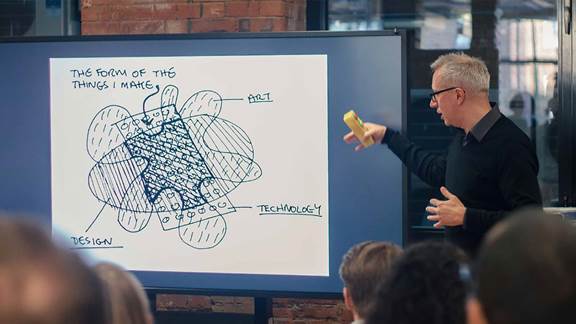Keep it simple
As engineers and designers, it is easy to become distracted by the excitement of new features and possibilities offered by new technology, yet in some cases, it is simplicity that drives the best and clearest user experience and most beautiful piece of design in a product. One of Kin + Carta’s principles is to make it simple, which helps us to understand and focus on communicating and solving what’s important.
Brendan loves things that just work. As an example, he talked about his alarm clock. It’s pretty smart but not too smart. It’s radio controlled, so always shows the right time. It has big clear buttons to and turn on/off the alarm. But most importantly, it’s not connected to the internet, so it never needs an update - it just works.
Brendan’s alarm clock reminds me that sometimes, simplicity drives the best and clearest experience - plus it’s also a beautiful piece of design.
Human emotion drives innovation and creativity
Although Brendan makes a living from tinkering with technology, his work is driven by the desire to evoke emotion from his audience. His projects are founded on the universal themes of joy, happiness, sadness and surprise to name a few. Technology is therefore only the vehicle to driving reactions forward.
Take, for example, his ‘Happiness Machine’, a small box that prints strips of ‘happiness receipts’. These short snippets of warming conversation are extracted from the site We Feel Fine and are printed through what is essentially a mini fax machine - a device that isn’t particularly special, but then, it doesn’t need to be. What Brendan highlights as important is the emotion that the device imparts, rather than the technology behind it.
A similar concept was then adapted many years later by Brendan for Airbnb called Local Murmurs. It allowed people to send in anecdotes on their neighbourhood via SMS that were then printed out through one of twelve custom printers. Each message was then displayed as a piece of art for people to read and enjoy.
Focus more on an enjoyable IoT user experience rather than the quickest one
As a product designer, I’m regularly trying to find the fastest and easiest way to meet a customer’s need - often removing unnecessary taps, closing gaps and taking the slack out of an experience. Yet, sometimes, you can find beauty in inconvenience.
During his talk, Brendan spoke about vinyl and what makes it great. I love vinyl. I’m not some hipster - I’ve just always had it, and have never yet let a record go to this date.
We live in an age where we are all used to accessing everything digitally at our fingertips, but sometimes there’s something great about having to go a little further.
For example, to play a record you must first stand up, choose a record, take it out of the sleeve, place it on the turntable, move the needle and then wait… wait while you hear a little crackle before the music starts. There’s magic that can be found in that moment of anticipation, and as Brendan highlights, it’s a magic that can easily be taken away when everything is available in an instant.
There’s a warmth in those extra steps that create a unique and special experience, that can often get overlooked when trying to find the shortest user route in a product. It’s not always about maximising speed of use, as this attitude can overlook a joyful experience.
It’s easy for anyone to get started
Above all, Brendan expressed his passion for continuously building on his knowledge of technology and in particular IoT in order to fuel his artistic vision. Similarly, at Kin + Carta Create we are constantly seeking new opportunities to learn about and play with technology so we can constantly improve our practice in what we do.
Whilst Brendan's preferred tech is the slightly more expensive Electric Imp, which allows an experiment to easily be taken into production, we have found Arduino to be a good place to start, for those wanting to dip their toes into the realm of IoT. It is also the tech we have been using in recently during our series of internal Internet of Things workshops, designed for Kin + Carta people to tinker and experiment in their own right. No matter what role or level of development, we’ve seen an extremely positive reaction from all who have attended, and the benefit has been widespread knowledge sharing, beyond our engineering team, that’s pushing IoT forward at a rapid pace at Kin + Carta.
Conclusion
With the continuing rise of industry interest in IoT, I’ve recently started prototyping and tinkering again, and after many years of concentrating on product design and customer experience predominantly through apps, Brendan’s talk could not have come at a better time.
It has reminded me and the wider community at Kin + Carta to not get hung up on technology, but to focus more closely on emotion and what people feel when they connect with things, and to rather use technology to fuel this. This is important to our approach, but it was a good, inspiring reminder. Personally, I plan to keep making - not polishing. Perhaps in a slick world of shiny new connected toys, it’s the rough edges that fuse the closest bond between your IoT experiment and the user. Polishing can come later.
